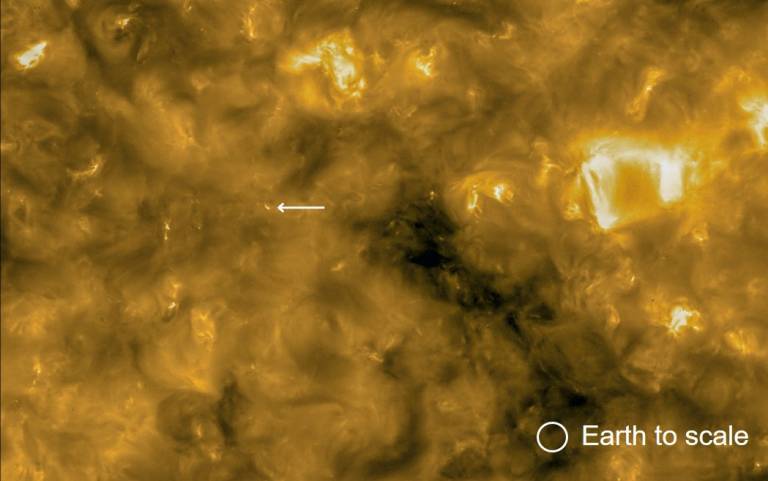‘Campfires’ offer clue to solar heating mystery
30 April 2021
Miniature solar flares nicknamed “campfires”, recently discovered near the surface of the Sun, are about 1,000 to 5,000 km tall and between 1-1.5 million degrees hot, finds a new study co-authored by UCL researchers.

The study compared data from Solar Orbiter, the Sun-observing mission by ESA and NASA, with observations from NASA’s Solar Dynamics Observatory to triangulate the height of the campfires.
The research was discussed at a Solar Orbiter first results session at the European Geosciences Union general assembly alongside a separate computer modelling study which found that the campfires were likely driven by a process that may contribute significantly to the heating of the Sun’s outer atmosphere, or corona.
Solar Orbiter, which contains instruments proposed, designed and built at UCL, revealed detailed images of the campfires months after launch last year. These were “first light” images from the Extreme Ultraviolet Imager (EUI), a suite of telescopes for which UCL is co-principal investigator and which provide images of the hot and cold layers of the Sun’s atmosphere and corona.
Since then the EUI has revealed more than 1,500 campfires. These short-lived brightenings last for between 10 and 200 seconds, and have a footprint covering between 400 and 4000 km. The smallest and weakest events, which had not been observed before, seem to be the most abundant, and represent a previously unseen fine structure of the region where the heating mystery is suspected to be rooted.
Dr David Long (UCL Mullard Space Science Laboratory), Co-Principal Investigator on the ESA Solar Orbiter Mission EUI Investigation and co-author of one of the two papers discussed this week, said: “With this work, we’ve been able to work out the temperature of these campfires (about 1-1.5 million degrees), and triangulate their height to between 1000-5000 km above the surface of the Sun, the photosphere.
“This tells us that while the loops are hot, they’re lower than expected, and in fact are much hotter than the surrounding atmosphere. These are really exciting results, and show that already we’re starting to see the potential of Solar Orbiter, both by itself and in conjunction with other observatories. I’m really looking forward to the start of the nominal science phase as we get closer to the Sun with all of the instruments working and observing together.”
Dr David Berghmans, Principal Investigator of EUI, said: “To our surprise, campfires are located very low in the solar atmosphere, only a few thousand kilometres above the solar surface, the photosphere.
“It is very early days, and we are still learning a lot about the campfire characteristics. For example, even though campfires look like small coronal loops, their length is on average a bit short for their height, suggesting we only see part of these little loops. But our preliminary analysis also shows that campfires do not really change their height during their lifetime, setting them aside from jet-like features.”
A separate simulation study, led by researchers at Peking University in China and the Max Planck Institute for Solar System Research in Germany, delved into the physics of the campfires, finding that a process called component reconnection appeared to be at work and could be enough to maintain the temperature of the solar corona predicted from observations. If replicated, this could add a key piece of the puzzle as to what makes the Sun’s outer atmosphere so much hotter than its interior – one of the biggest mysteries in solar physics.
ESA’s Solar Orbiter Project Scientist Daniel Müller said: “How fantastic to already have such promising data that may provide insight into one of solar physics’ greatest mysteries before Solar Orbiter has even begun its nominal science phase.
“Our mission is lucky to be building on the incredible ground-work of those that have flown before, and the theories and models already put forward over the last decades. We’re looking forward to see what missing details Solar Orbiter – and the solar community working with our data – will contribute to solving open questions in this exciting field.”
Solar Orbiter carries a scientific payload consisting of 10 remote sensing and in situ instruments. In addition to EUI, UCL also has a Principal Investigator role in the Solar Wind Analyser (SWA) suite, which makes in situ measurements of the solar wind charged particle populations.
Solar Orbiter is currently in “cruise phase”, which for EUI and the remote sensing payload is focused primarily on instrument calibration. However, SWA and the other in situ sensors are in regular operation during this period. The full payload complement will begin coordinated observations at the start of the nominal mission in November this year.
Links
- ESA Solar Orbiter
- ESA story
- Dr David Long’s academic profile
- UCL Mullard Space Science Laboratory
- UCL Mathematical & Physical Sciences
Image
- Solar Orbiter spots ‘campfires’ on the Sun: A high-resolution image from the Extreme Ultraviolet Imager (EUI) on ESA’s Solar Orbiter spacecraft, taken with the HRIEUV telescope on 30 May 2020. The circle in the lower right corner indicates the size of Earth for scale. The arrow points to one of the ubiquitous features of the solar surface, called ‘campfires’ and revealed for the first time by these images. On 30 May, Solar Orbiter was roughly halfway between the Earth and the Sun, meaning that it was closer to the Sun than any other solar telescope has ever been before. Credit: Solar Orbiter/EUI Team (ESA & NASA); CSL, IAS, MPS, PMOD/WRC, ROB, UCL MSSL
Media contact
Mark Greaves
T: +44 (0)7990 675947
E: m.greaves [at] ucl.ac.uk
 Close
Close

